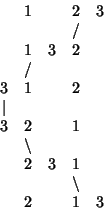|
|
|
The rearrangement of elements in a set into a One-to-One correspondence with itself, also called an
Arrangement or Order. The number of ways of obtaining ![]() ordered outcomes from a permutation of
ordered outcomes from a permutation of ![]() elements is
elements is
| (1) |
A representation of a permutation as a product of Cycles is unique (up to the ordering of
the cycles). An example of a cyclic decomposition is (![]() ,
, ![]() ), corresponding to the permutations (
), corresponding to the permutations (![]() ,
, ![]() ,
, ![]() ) and (
) and (![]() ), which combine to give
), which combine to give
![]() .
.
Any permutation is also a product of Transpositions. Permutations are commonly denoted in Lexicographic or Transposition Order. There is a correspondence between a Permutation and a pair of Young Tableaux known as the Schensted Correspondence.
The number of wrong permutations of ![]() objects is
objects is ![]() where
where ![]() is the Nint function. A permutation of
is the Nint function. A permutation of ![]() ordered objects in which no object is in its natural place is called a Derangement (or sometimes, a Complete
Permutation) and the number of such permutations is given by the Subfactorial
ordered objects in which no object is in its natural place is called a Derangement (or sometimes, a Complete
Permutation) and the number of such permutations is given by the Subfactorial ![]() .
.
Using
 |
(2) |
 |
(3) |
The set of all permutations of a set of elements 1, ..., ![]() can be obtained using the following
recursive procedure
can be obtained using the following
recursive procedure
 |
(4) |
 |
(5) |
Let the set of Integers 1, 2, ..., ![]() be permuted and the resulting sequence be divided into
increasing Runs. As
be permuted and the resulting sequence be divided into
increasing Runs. As ![]() approaches Infinity, the average length of the
approaches Infinity, the average length of the ![]() th Run is denoted
th Run is denoted
![]() . The first few values are
. The first few values are
| (6) | |||
| (7) | |||
| (8) |
See also Alternating Permutation, Binomial Coefficient, Circular Permutation, Combination, Complete Permutation, Derangement, Discordant Permutation, Eulerian Number, Linear Extension, Permutation Matrix, Subfactorial, Transposition
References
Bogomolny, A. ``Graphs.''
http://www.cut-the-knot.com/do_you_know/permutation.html.
Conway, J. H. and Guy, R. K. ``Arrangement Numbers.'' In The Book of Numbers. New York: Springer-Verlag, p. 66, 1996.
Dickau, R. M. ``Permutation Diagrams.''
http://forum.swarthmore.edu/advanced/robertd/permutations.html.
Knuth, D. E. The Art of Computer Programming, Vol. 1: Fundamental Algorithms, 2nd ed. Reading, MA: Addison-Wesley, 1973.
Kraitchik, M. ``The Linear Permutations of
Le Lionnais, F. Les nombres remarquables. Paris: Hermann, pp. 41-42, 1983.
Ruskey, F. ``Information on Permutations.''
http://sue.csc.uvic.ca/~cos/inf/perm/PermInfo.html.
Sloane, N. J. A. Sequence
A000142/M1675
in ``An On-Line Version of the Encyclopedia of Integer Sequences.''
http://www.research.att.com/~njas/sequences/eisonline.html and Sloane, N. J. A. and Plouffe, S.
The Encyclopedia of Integer Sequences. San Diego: Academic Press, 1995.
![]() Different Things.'' §10.1 in Mathematical Recreations.
New York: W. W. Norton, pp. 239-240, 1942.
Different Things.'' §10.1 in Mathematical Recreations.
New York: W. W. Norton, pp. 239-240, 1942.
|
|
|
© 1996-9 Eric W. Weisstein